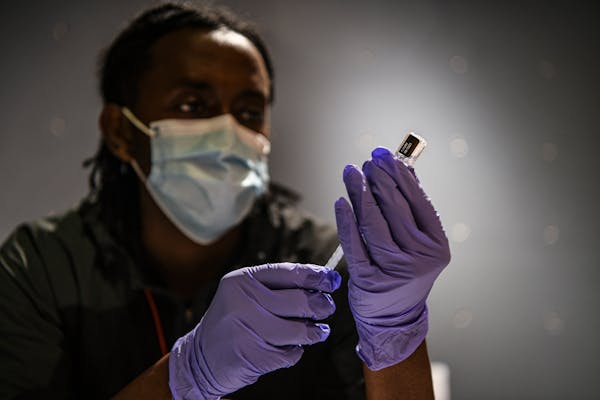Minnesota might have finally reached a fresh positive pandemic milestone — the first day since Aug. 15 that no one from the state died of COVID-19.
Wednesday's pandemic update from the Minnesota Department of Health showed zero COVID-19 deaths reported so far on March 12. That could change, given delays in reporting and verifying COVID-19 deaths, but it nonetheless is the latest sign that Minnesota has emerged from its fifth pandemic wave.
The state on Wednesday reported two more COVID-19 deaths, raising its pandemic total to 12,342. But its average has declined from 33 deaths per day in the week ending Jan. 30 to as few as six per day in the week ending March 12.
COVID-19 hospitalizations also declined from a peak of 1,629 on Jan. 14 to 235 Tuesday. The latest total of 30 COVID-19 patients requiring intensive care is the lowest since July 21.
"The amount of community spread … is pretty small," said Dr. Paul Mueller, regional vice president for Mayo Clinic Health System in the border town of La Crosse, Wis. "In fact, we've had days here in La Crosse where we have had zero positive tests."
Minnesota's positivity rate of COVID-19 testing has dropped from 23.5% in the week ending Jan. 11 to 2.8% on March 15, but the rate of decline has also started to slow. The current rate remains above the pandemic low of 1.1% in late June.
Comparisons with last summer offer a reminder that declines in COVID-19 activity can be temporary. Minnesota repealed a mask mandate last summer when it appeared that rising vaccinations had suppressed the pandemic, but more infectious variants emerged in the fall and winter when immunity from those shots had waned.
Protections have declined again in Minnesota, according to an update this week from the Institute for Health Metrics and Evaluation (IHME) in Washington state. The share of Minnesotans always wearing masks in public declined over the past two months from 40% to 23%. Mobility levels as measured by mobile devices are only 6% below typical levels.
People should stay up to date with vaccinations and protect themselves with masks or social distancing if they are concerned about viral exposure, said Dr. Gregory Poland, director of the Mayo Clinic Vaccine Research Center. "The news is good here. Case rates are way, way down. The issue that I think all of us are promoting is 'Let's keep it that way.' "
A resurgence of COVID-19 in Europe is being fueled partly by the BA.2 subvariant of the coronavirus that is quickly becoming the dominant source of U.S. infections as well.
The subvariant spreads 30% faster than the also highly infectious omicron variant that caused the last wave, said Dr. Raj Palraj, a Mayo infectious disease specialist. However, both omicron and the subvariant produce lower rates of severe illnesses and ICU cases than previous iterations of the virus. Vaccines appear to offer protection against BA.2 as well, he added.
IHME estimates 69% of Minnesotans have been infected at least once by the coronavirus. That's lower than the 75% estimate for the nation and the more than 80% estimates for Iowa and Wisconsin. The modeling organization projects that Minnesota's high level of immunity through vaccination and recent infections will keep COVID-19 activity relatively low in the early spring.
Minnesota ranks second among states with almost 60% of fully vaccinated people 12 and older having received booster doses to maintain their immunity.
The state also has a more robust supply of COVID-19 treatments if another wave emerges. When two of three monoclonal antibody treatments proved ineffective against omicron, the state late last year rationed its courses of the effective version for the neediest patients.
As of Friday, Minnesota had 3,205 courses of that antibody therapy and 2,222 courses of a newly approved version. The state also had 6,096 courses of Paxlovid COVID-19 antiviral pills and 13,779 courses of the less effective molnupiravir.
However, most projections of total infections and immunity levels in Minnesota amount to little more than "pixie dust," cautioned Michael Osterholm, director of the University of Minnesota's Center for Infectious Disease Research and Policy. They are based on static and uncertain assumptions about COVID-19 immunity levels that are always changing with time and viral mutations.
Studies show that immunity is strongest shortly after vaccination or infection, especially in people who have had both. Osterholm urged vaccination and continued precautions to avoid getting infected as the safest route.
"Nobody is going to say get infected so you can get protection," he said, "because that could be the infection that kills you."
Carolyn Parnell, 'trailblazer' who served as Minnesota's first IT commissioner, dies

